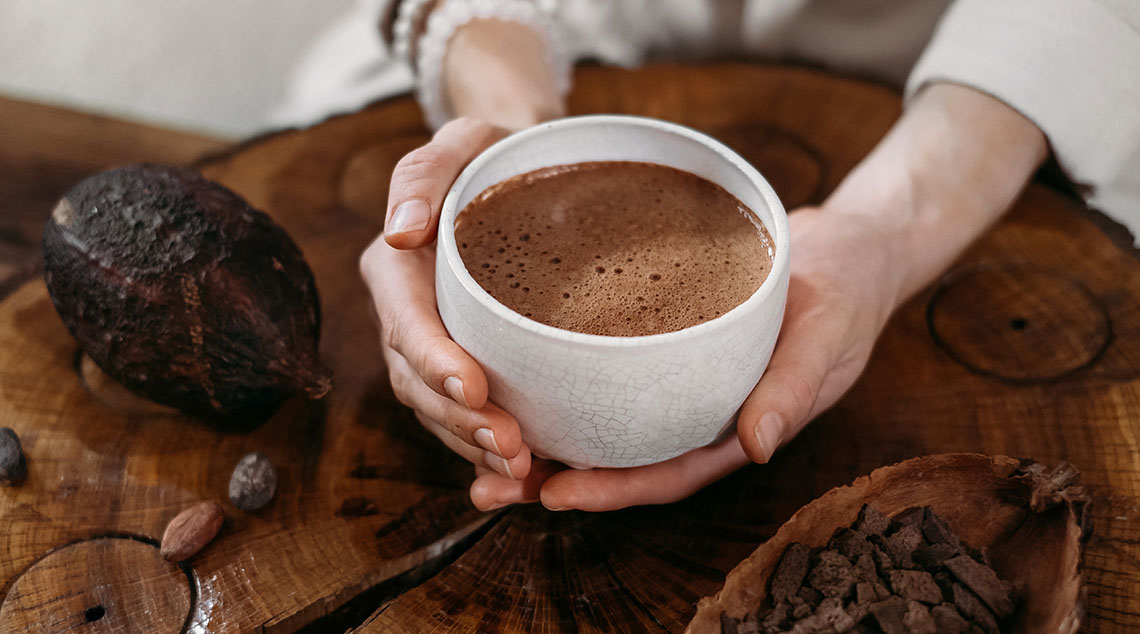Why ceremonial cacao should be your next chocolate fix
Ceremonial cacao is the ultimate upgrade for chocolate lovers. But what is it and how can it transform your sweet cravings into a health-boosting ritual?
Whether you are treating yourself to a deliciously rich piece of dark chocolate or cosying up with a cup of hot cocoa on a chilly winter night, chocolate has long been lauded for its ability to soothe the soul and lift your spirits.
But what if you could take your chocolate fix to the next level?
Enter ceremonial cacao — a minimally processed form of your favourite indulgence.
What is ceremonial cacao?
Ceremonial cacao is a pure cacao bean paste that has been appreciated for hundreds of years throughout Central America for its health-restoring and mood-elevating properties, naturopath Jade Walker explains.
“Cacao was one of their main sources of food, it was a beautiful crop that everyone grew,” Jade, Hey Sister health and wellness director, says.
Over time, it became more highly revered and its consumption became associated with important milestones, she explains, so anytime there was something to celebrate — births, marriages, deaths — it was brought out.
“And that is what we call ceremonial cacao, where it is the whole cacao bean paste,” Jade says.
Is ceremonial cacao different from cacao powder?
Ceremonial-grade cacao is a term for beans that have been fermented, lightly toasted, ground into a paste and dried as a block, and then broken into pieces, Jade explains.
“It looks like shards of dark chocolate,” she says.
“It is minimally processed, so it’s still holding all the key components of the cacao plant including essential vitamins, minerals, and macronutrients like fats and proteins.”
Jade says cacao powder is produced on a more industrial scale, which strips a lot of the naturally occurring nutrients from the cacao bean, while ceremonial grade cacao is left as a whole food with nothing added or removed.
“It (ceremonial cacao) is basically pure chocolate,” she says.

Why is ceremonial cacao so popular?
Offering a unique blend of spiritual connection and beneficial properties, ceremonial cacao has gained favour in wellness circles.
It is rich in feel-good compounds such as theobromine, contains antioxidant-rich polyphenols, and provides a handy dose of magnesium, selenium and iron.
Traditionally, ceremonial cacao has been known as a “heart opener” and has been believed to promote feelings of love, connection and empathy, Jade says, while its nutritional profile offers a range of health benefits.
“Being a ‘heart opener’ can be interpreted in a spiritual, energetic way, but science shows one of its active constituents, theobromine, also helps relax the heart muscle and encourages oxygen to the heart,” she says.
Can you drink ceremonial cacao every day?
While rituals celebrating ceremonial cacao are still popularly observed, and you can even attend ceremonial cacao parties, Jade says ceremonial cacao can easily be weaved into your everyday lifestyle.
“It’s becoming a popular substitute for coffee,” she notes.
“The extra fats in it that come from the cocoa butter help to slowly release it into the bloodstream so we get more of that sustained, clear energy.”
Emphasising the importance of always sourcing FairTrade and ethically farmed ceremonial cacao, Jade recommends it to her clients as a caffeine alternative and enjoys it each day herself.
“I love the clarity I get from cacao; it just makes me feel clear, focused, but also grounded.”
Jade explains 15-20g is considered a daily practice dose, while in ceremony you might have 40-50g.
“The ceremonial dose is not recommended daily,” she says.
How to make ceremonial cacao
Jade says making a nice hot cup of ceremonial cacao is simple.
She uses a Thermomix, but it is also easily done on a stovetop.
“I put in around 15-20 grams of ceremonial cacao with some water, and maybe a dash of almond milk or maple syrup, and turn it to 80 degrees for about four minutes, and it’s done,” she says.
If you don’t have a Thermomix, combine the above ingredients in a pot on the stovetop and heat until melted down and combined.
Jade says like cacao powder and cocoa, ceremonial cacao can be used in cooking and making desserts.
“It doesn’t have to be consumed as a drink — you can use it to make a healthier chocolate cake or ice cream.”
Try these chocolate recipe ideas:
- Luke Hines’ gluten-free one-pan chocolate mud cake
- Keto-friendly homemade chocolate
- Luke Hines’ salted chocolate thick shake
- Kidney bean chocolate muffins with avocado icing
- Chocolate mousse torte with blueberries
Written by Claire Burke.




